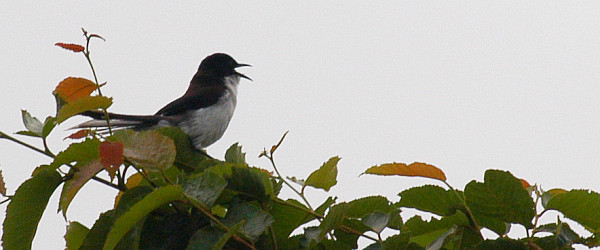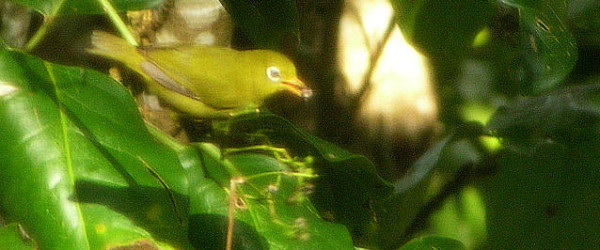Hi, folks! This is the first of what will be my monthly posts on bird taxonomy and systematics. But don’t worry, I’ll do my best to make them accessible and even fun. I first encountered 10,000 Birds back in 2004, well before the world had Twitter, Google Maps, or iPhones. (I guess we just sat around all day banging rocks together — I don’t really remember.) Over the years, Mike, Charlie, and Corey have built this site into something that serves birders all over the world and inspires each of us to conservation action. I’m thrilled to be joining the team!
So … where to begin? Let’s start with a group of birds that have puzzled and frustrated scientists for at least a hundred years: the babblers.

Dark-backed Sibia (Heterophasia melanoleuca), a babbler, sings on a foggy morning in Thailand. © David J. Ringer
Babblers are a huge group of mostly insectivorous, often social, sometimes drab, usually nonmigratory, and generally non-dimorphic species widespread in the Old World. The composition of this group and its relationship to other groups has been unclear (at best) for decades. In the last few years though, a new wave of DNA sequence studies has splintered this section of the passerine tree into matchsticks, and an exciting new structure — punctuated by some significant surprises — has started to emerge from the chaos.
Last month, the IOC World Bird List became the first major world list to act on the accumulating evidence with a bold restructuring of the babblers. We’ll take a peek at the new structure in a minute, but let’s back up a bit first.
Babblers belong to a major clade of oscine passerines called Sylvioidea, which also includes larks, swallows, bulbuls, long-tailed tits, cisticolas, and “Old World warblers.” Throughout most of ornithological history, scientists have grouped a wide variety of puzzling, plain, and understudied species with the babblers.
Twenty years ago, the watershed Sibley and Ahlquist and Sibley and Monroe publications, based on a decade and a half of DNA-DNA hybridization work, removed the most obvious misfits from the babbler assemblage (e.g., the legendary African rockfowl Picathartes and the five Australasian Pomatostomatus “babblers”). They submerged the babbler family, Timaliidae, into the Old World warbler family, Sylviidae, resulting in a Sylviidae that contained a staggering 560 species. Two associated families, the cisticolas (Cisticolidae) and white-eyes (Zosteropidae) contained 120 and 95 species respectively.
Ten years later in 2000, the fifth edition of James F. Clements’ Birds of the World: A Checklist also recognized Cisticolidae and Zosteropidae but split the other species into three families:
- Old World warblers (Sylviidae), 279 species;
- Babblers (Timaliidae), 265 species;
- Parrotbills (Paradoxornithidae), 20 species.
Now another 10 years have passed, and the world looks very different. For one thing, the Old World warblers have been split apart into many new families, many of which stayed in Sylvioidea, but a few of which did not. (The AOU North American Checklist Committee finally removed gnatcatchers from Sylviidae this year; they belong near wrens, nuthatches, and creepers in a nearby branch of the passerine tree.)
It is at last becoming possible to answer with some confidence the question, what is a babbler?
A babbler, in a taxonomic sense, can be thought of as any of about 450 species in five major clades:
Sylviidae
Surprise! Sylvia, the type genus of what was once the “typical warbler” family Sylviidae, is in fact closely related to several babbler genera, including some fulvettas and birds like Yellow-eyed Babbler. This means that several familiar European birds like Blackcap, Garden Warbler, and whitethroats, are in fact babblers. The Asian parrotbills (excluding Panurus biarmicus, the Bearded Reedling, which is sister to the larks) belong here, not in their own family. And the North American Wrentit belongs here too. It retains the distinction of being the only New World member of this 450-strong assemblage.
Zosteropidae
Next are the white-eyes and their closest relatives, which include several Asian babblers previously classified in Timaliidae, including most yuhinas and several Philippine species formerly classified in Stachyris. This family’s 125 species of small, often frugivorous birds, are distributed across Africa, tropical Asia, Australasia and the Pacific. Its members are the only babblers that crossed Wallace’s Line to any significant degree. They are the only babblers in Australia, New Zealand, and the Pacific islands. White-eyes are known for their propensity to colonize and recolonize islands and mountain ranges, rapidly diversifying into a dizzying array of similar-looking species.

A Louisiade White-eye (Zosterops griseotinctus) nabs a berry on Nissan Island, Papua New Guinea. © David J. Ringer
Timaliidae
The greatly reduced Timaliidae consists of 50-60 typical babblers, some scimitar babblers, some wren-babblers, and tit-babblers distributed across south and east Asia and the Malay Archipelago.
Pellorneidae
This group of 70 species occurs from Africa (Illadopsis) across south and east Asia and in the Philippines and Indonesian islands. Members include some fulvettas, some scimitar babblers, and some wren-babblers.
Leiothrichidae
A large group (~130) of babblers, which like the previous group, has representatives in Africa and widely through Asia and the Indonesian islands west of Wallace’s Line. Well-known subgroups include the laughingthrushes, the minlas, the sibias, and the Turdoides babblers.
For a full list of the genera currently placed in each group, see the IOC’s babbler families review page.
In the list above, I have treated the babbler clades as families, which is the approach provisionally adopted in version 2.6 of the IOC World Bird List. I asked renowned ornithologist Dr. Frank Gill to explain why his team took that approach, as opposed to classifying them as subfamilies of one large babbler family.
“We opted to treat these babbler clades as families pending further resolution of their relationships and compositions,” he wrote. “We could have gone either way, really, but doing so has some advantages. A number of colleagues aren’t ready to submerge the Zosteropidae into a giant babbler family, so if we retain it, family status for the others feels right. Our treatment also parallels the family status accorded to the Old World warbler clades and others.”
He continued, “We lack a truly robust phylogeny of these clades that resolves their hierarchical relationships as well as sequences,” but he tells me that in the next year or two, we’ll see additional studies coming out that will continue to clarify things.
I asked him if he thinks these five babbler groups will stand.
“These clades are likely to last, though compositions may change,” he replied. “Possibly some may be split into two, or produce an outlying, unrelated group like Pnoepyga.”
Of course, even if the five clades do hold up and their membership is sorted out, it’s a taxonomic decision as to whether the various groups are treated as full families or subfamilies. In any case, it’s exciting to see some clarity and structure emerging after so many decades of uncertainty. I know one thing for sure. I need to get on a plane for Asia as soon as possible! The babbler section of my life list is painfully short. There’s a lot of babbler-y goodness out there to explore.
If you’ve made it this far, congratulations! Now it’s time for the bonus round! Here are several birds that were recently considered part of the babbler families but belong elsewhere:
Pnoepyga wren-babblers
These tiny and completely adorable birds turned out not to be babblers at all and are placed in their own small family, Pnoepygidae. They do still belong to the Sylvioidea, however, so they weren’t as badly misplaced as some of the other non-babblers.
Cinnamon Ibon
This Philippine “white-eye” was discovered this year to be an Old World sparrow in the family Passeridae!
Oxylabes, Hartertula, and Crossleyia
These monotypic genera, along with several species previously classified in Sylviidae, turn out to belong to a recently discovered sylvioid “Malagasy warbler” radiation on Madagascar, which is given the family name Bernieridae. (Other well-known island radiations include the Hawaiian finches and the Galapagos “finches,” which are actually tanagers.)
Spot-throat, Dapple-throat, and Gray-chested Babbler
These three African “babblers” actually belong with the southern African sugarbirds.
White-bellied Erpornis and Shrike-babblers
These birds were considered typical babblers but turned out to belong in a completely different section of the passerine tree. They are now placed in the Vireonidae with New World species like Red-eyed Vireo and Rufous-browed Peppershrike. Vireos are part of the Corvoidea, along with shrikes, monarch flycatchers, drongos, birds-of-paradise, jays, crows, and ravens. Vireonidae was considered an exclusively New World family, but no other member of the Corvoidea is exclusively New World. Thus, the “discovery” of these Old World vireo relatives makes a great deal of biogeographic sense.
Undoubtedly, more surprises await. And we will explore them together in the months and years to come. It’s an exciting time to be a birder!
References and further information
Boyd, J (2010) SYLVIOIDEA III: Sylviidae through Leiothrichidae. Taxonomy in Flux.
Cibois, A et al. (2010) Bernieridae (Aves: Passeriformes): a family-group name for the Malagasy sylvioid radiation. Zootaxa, 2554, 65–68.
Clements, J (2000) Birds of the World: A Checklist. Ibis Publishing Company.
Fjeldså, J (2010) The Cinnamon Ibon Hypocryptadius cinnamomeus is a forest canopy sparrow. Ibis, 152, Issue 4, 747–760.
Gelang, M et al. (2009) Phylogeny of babblers (Aves, Passeriformes): major lineages, family limits and classification. Zoologica Scripta, 38, 225–236.
Gill, F (2010) pers. comm.
Gill, F and D Donsker, Eds. (2010) IOC World Bird Names (version 2.6).
Johansson, U et al. (2008) Phylogenetic relationships within Passerida (Aves: Passeriformes): A review and a new molecular phylogeny based on three nuclear intron markers. Molecular Phylogenetics and Evolution, 48 (2008), 858–876.
Roberson, D (2010) Bird Families of the World 9th Ed.
Sly, N (2009) The New Vireos. Biological Ramblings.













Oh crap… That’s fascinating, certainly, but also pretty complex matter. Can’t we return to the times when we sat around all day banging rocks together?
🙂
Thanks for that great summary of babbler – or whatever – taxonomy. I’ll certainly look at my Sylvia warblers very differently next spring when they return from, from … wait a minute! From AFRICA !?
Fascinating, David. You’ve got a knack for tackling tough topics!
Very helpful, David, thank you!
The Cinnamon Ibon is actually a sparrow? At this point I’m fairly sure some of these out-there suggestions are an elaborate hoax perpetuated by geneticists. The Silktail is actually a fantail. The Oo’s are really waxwings. I look forward to being told that the Kiwi is actually a King Charles Spaniel….
Seriously though, interesting read. We’ve had a passionate taxonomist on Wikipedia reworking all our passerines for a while now. Its a shame the Handbook of the Birds of the World was published before or as a lot of this came out.
Our Grey-crowned Babblers seem to always come in a group of 8!They come into your garden chuckling away to themselves throwing leaf litter about looking for insects,etc.A very comical bird.
Excellent post David – you’ve been missed! Welcome back!
Duncan – “the Kiwi is actually a King Charles Spaniel” – brilliant! 🙂
I am astounded (slack-jawed and babbling might be a better description) at the wealth of information in this post. If this is a sign of things to come I can’t wait until your next post!